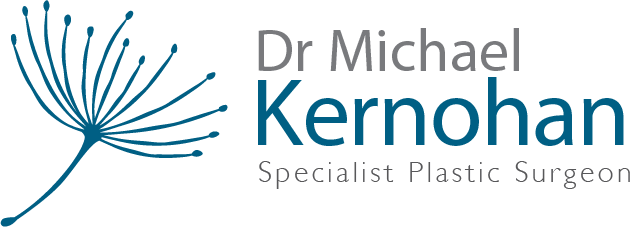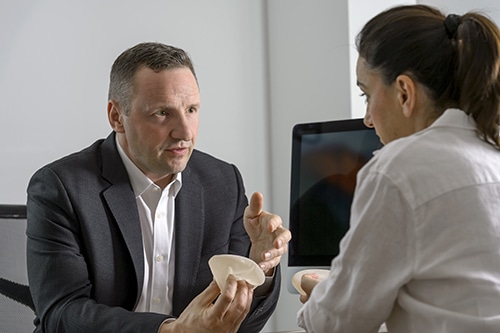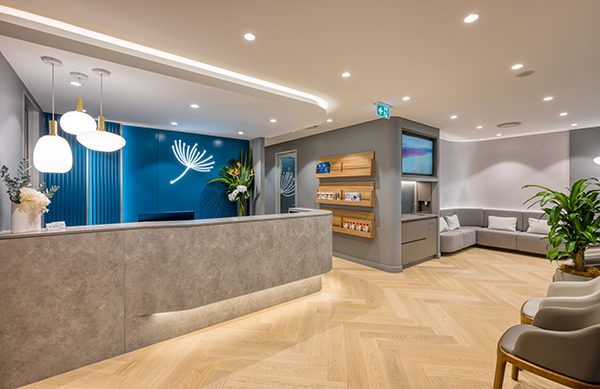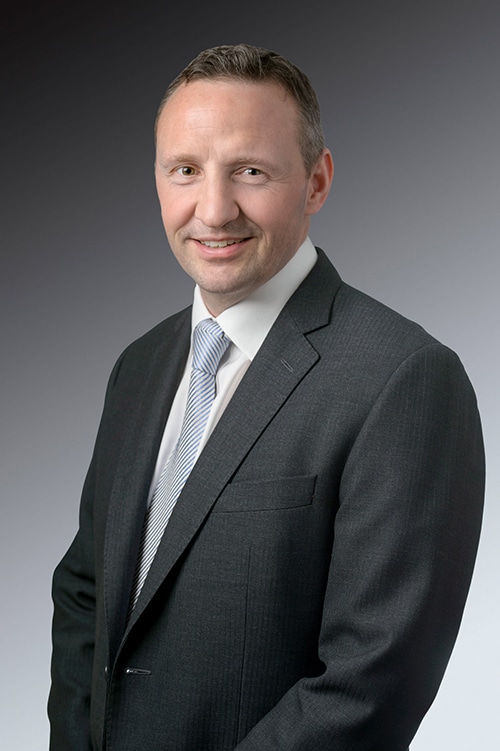Understanding Tummy Tuck (Abdominoplasty) Scars
- Are you planning to get an abdominoplasty?
- Do you want to know more about how the scars will look like after the surgery?
- Are you interested in the details of the different types of tummy tuck scars?
Tummy tuck (Abdominoplasty) surgery is a popular cosmetic procedure used to remove excess skin and fat from the abdomen while tightening the underlying muscles. This results in a flatter, firmer, and more contoured stomach. However, as with any surgery, scarring is an inevitable part of the healing process. Abdominoplasty scars vary in appearance, depending on factors like genetics, the specific procedure, and the patient’s ability to heal. This blog will discuss different types of tummy tuck scars, abnormal scars, keloids, hypertrophic scars, and frequently asked questions about these issues.
Sydney Specialist Plastic Surgeon Dr Michael Kernohan is a talented plastic surgeon who performs tummy tuck and other body contouring procedures with an emphasis on minimising scarring. He understands that scarring can be a concern for many patients, and he takes great care to create incisions in less visible locations and to use techniques that promote optimal healing.
Take the Quiz
Types of Tummy Tuck Scars
Abdominoplasty scars can vary in appearance depending on the specific procedure performed. Here are the common types of tummy tuck scars based on the different tummy tuck procedures:
Traditional Abdominoplasty Scars
A traditional tummy tuck, or full abdominoplasty, is a surgical procedure aimed at removing excess skin and fat from the abdomen while tightening the underlying muscles. This procedure results in a flatter, firmer, and more contoured stomach with the cost of post-op scarring. Understanding the nature and appearance of traditional tummy tuck scars can help patients manage their expectations and be better prepared for post-operative care.
The scars resulting from a traditional abdominoplasty have two components:
- Horizontal Scar: The primary incision in a traditional tummy tuck/ abdominoplasty is made horizontally across the lower abdomen, just above the pubic area. This scar usually extends from one hip bone to the other, following the natural curve of the body. Over time, the scar will fade and flatten, becoming less noticeable. However, it is important to note that the length, thickness, and overall appearance of the scar can vary depending on factors such as genetics, surgical technique, and the patient’s healing process.
- Umbilical Scar: In addition to the horizontal scar, a traditional tummy tuck/abdominoplasty may also result in a small, circular scar around the navel. This occurs when the surgeon needs to reposition the belly button due to the removal of excess skin. Although this scar is usually well-concealed within the natural contours of the belly button, it is still a scar that might be visible after the surgery.
Mini Tummy Tuck/ Abdominoplasty Scars
The primary scar resulting from a mini tummy tuck/ abdominoplasty is a horizontal incision made just above the pubic area. This scar is shorter and usually more discreet than the scar from a traditional tummy tuck/ abdominoplasty, as it does not extend as far across the lower abdomen. The length of the scar depends on the amount of skin and fat removed, as well as the patient’s body shape.
Since a mini abdominoplasty does not involve repositioning the belly button or repairing the rectus muscle, there is no additional scarring around the navel. This is one of the key differences between mini and traditional abdominoplasty procedures.
Extended Tummy Tuck – Abdominoplasty Scars
The scar resulting from an extended abdominoplasty is similar to the horizontal incision made in a traditional abdominoplasty, but it is longer. The incision extends around the flanks or hips, wrapping around the sides of the body. This allows the surgeon to remove excess skin and fat from the abdomen, flanks, and lower back, providing more comprehensive contouring and tightening of the midsection.
In addition to the extended horizontal scar, an extended tummy tuck/ abdominoplasty may also involve a small, circular scar around the navel if the surgeon needs to reposition the belly button due to the removal of excess skin.
Circumferential Tummy Tuck/ Abdominoplasty Scars
Circumferential tummy tuck/ abdominoplasty needs a horizontal incision that encircles the entire waistline. This incision allows your surgeon to remove excess skin and fat from the abdomen, flanks, lower back, and buttocks, providing comprehensive contouring and tightening of the entire midsection. The scar usually follows the natural curve of the body, and it may be concealed by underwear or swimwear.
In addition to the circumferential scar, a circumferential abdominoplasty may also involve a small, circular scar around the navel.
Abnormal Scarring after Abdominoplasty
Abnormal scars can form after a tummy tuck/ abdominoplasty procedure, and they may require additional treatment or intervention. These scars are typically raised, discoloured, and may cause discomfort. Two common types of abnormal scars include keloids and hypertrophic scars, which will be discussed in more detail below.
Keloid scars
Keloid scars are a type of abnormal scarring characterised by an overgrowth of fibrous tissue beyond the boundaries of the original wound or incision. They are raised, thick, and often dark or reddish-purple in colour. Keloids can be itchy, painful, or tender and may continue to grow over time. These scars are caused by excessive production of collagen during the healing process and are more common in people with darker skin tones.
Several factors may contribute to the formation of keloid scars, including genetics, wound tension, infection, and the location of the injury. Some areas of the body, such as the chest, shoulders, earlobes, and upper arms, are more prone to keloid formation. However, keloids can develop in response to various types of skin injuries, including surgical incisions, burns, piercings, and even minor injuries like insect bites or acne.
Hypertrophic scars
Hypertrophic scars are a type of raised, thickened scar that forms as a result of an overactive healing response following an injury or surgery. These scars are characterised by their red or pink appearance and their tendency to remain within the boundaries of the original wound or incision. Although hypertrophic scars may appear similar to keloids, they are generally less aggressive and do not extend beyond the initial injury site.
Hypertrophic scars usually develop within a few weeks to months after an injury or surgery, and their formation can be influenced by factors such as genetics, skin type, the size and depth of the wound, and the location on the body. These scars can be itchy, painful, or tender, especially during the initial stages of healing.
Over time, hypertrophic scars may improve in appearance, becoming flatter, softer, and lighter in colour. However, some hypertrophic scars may persist, and several treatments can help accelerate the healing process and improve their appearance
Click to Download Dr Michael Kernohan’s Abdominoplasty Surgery Guide
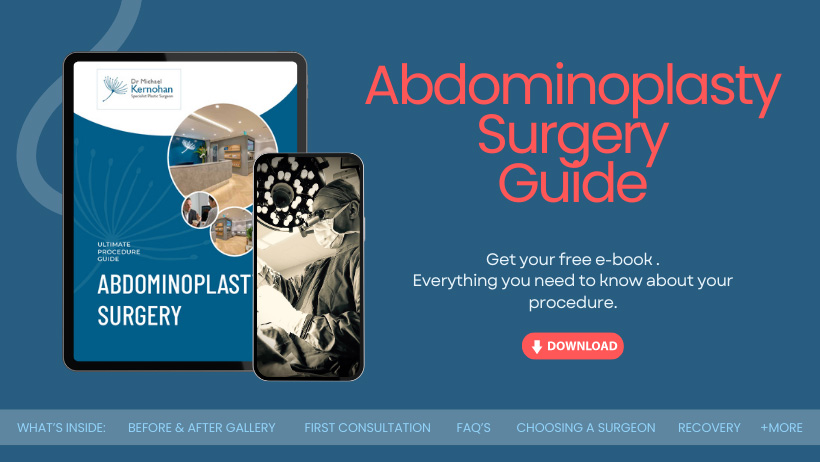
Tips on How to Reduce the Visibility of Abdominoplasty Scars
To minimise tummy tuck scars and promote the best possible healing process, follow these tips:
- Avoid smoking: Smoking impairs the healing process and can increase the risk of more noticeable scarring. Quit smoking well before your surgery and avoid it throughout the healing process
- Wear a compression garment: Wearing a compression garment as recommended by your surgeon can help reduce swelling, support the healing tissues, and potentially improve the appearance of the scar
- Apply silicone gel sheets or scar creams: Silicone gel sheets or silicone-based creams can help keep the scar hydrated and protected, promoting a flatter and less noticeable scar. Consult your surgeon before using any scar treatment products
- Avoid sun exposure: Protect your scar from sun exposure by covering it with clothing or applying sunscreen with a high SPF. Sun exposure can cause scars to darken and become more noticeable
- Massage the scar: Gently massaging the scar with clean fingers or a non-irritating lotion can help break down scar tissue, increase blood flow, and promote healing. Always consult your surgeon before starting any scar massage
- Vitamin E, a powerful antioxidant with skin-nourishing properties, has long been touted as a potential treatment for minimising tummy tuck scars. When applied topically, vitamin E is thought to promote skin healing, moisturise the scar tissue, and reduce inflammation, potentially resulting in a flatter and less noticeable scar. However, it’s essential to note that scientific evidence on the efficacy of vitamin E in scar reduction is mixed, with some studies suggesting it may not provide significant improvements. Before using vitamin E or any other topical treatment on your tummy tuck- abdominoplasty scar, consult with your surgeon to ensure it is appropriate for your situation and won’t interfere with the healing process.
Treatment Options for Keloid and Hypertrophic Scars
Some common treatments include:
- Corticosteroid injections: Intralesional corticosteroid injections can help reduce inflammation and slow the growth of keloid scars. Multiple injections may be required over several months for optimal results
- Silicone sheets or gels: Silicone sheets or gels applied to the scar can help soften and flatten keloids by applying constant pressure and hydration to the area. This treatment may take several months to show noticeable improvements
- Cryotherapy: Freezing the keloid tissue with liquid nitrogen can help reduce the size of the scar. Cryotherapy is often combined with other treatments, such as corticosteroid injections, for better results
- Laser therapy: Lasers can be used to reduce the redness, itching, and pain associated with keloids. They may also help flatten and minimise the appearance of the scar. Multiple laser treatments may be necessary for optimal results
- Surgical removal: In some cases, your surgeon may recommend the surgical removal of the scar

FAQs about Tummy Tuck Scars
How long does it take for abdominoplasty scars to fade?
- The healing process for tummy tuck scars can vary depending on factors such as genetics and skin type. Generally, scars begin to fade and flatten within 6 to 12 months but may take up to 2 years or more to reach their final appearance. It’s important to be patient and follow your surgeon’s post-operative care instructions to promote optimal healing.
Can tummy tuck scars be completely eliminated?
- While plastic surgeons use advanced techniques to minimise scarring, complete elimination of abdominoplasty scars is unlikely. Scars will fade and become less noticeable over time, but some degree of visible scarring will remain. Choosing an experienced surgeon and adhering to post-operative care recommendations can help minimise scarring and achieve an optimal outcome.
What can I do to prevent infection and minimize scarring after a tummy tuck- abdominoplasty?
To minimise the risk of infection and promote optimal healing, follow your surgeon’s post-operative care instructions, which may include:
- Keeping the incision site clean and dry
- Changing dressings as recommended
- Taking prescribed medications, such as antibiotics, as directed
- Wearing a compression garment
- Avoiding strenuous activities that may strain the incision site
- Not smoking, as it can impair the healing process
When can I start using scar treatments on my abdominoplasty scar?
- Before starting any scar treatments, consult your surgeon for guidance. He will provide specific recommendations based on your individual healing process and the type of scar treatment you are considering. Generally speaking, you should wait until the incision site is fully closed and healed before applying any scar treatment products or undertaking additional treatments.
Can fat come back after tummy tuck?
- After a tummy tuck (abdominoplasty), it is possible for fat to accumulate in other areas of the body if you do not maintain a healthy lifestyle. A tummy tuck (abdominoplasty) removes excess skin and fat from the abdominal area and tightens the underlying muscles. However, it does not prevent future weight gain or fat accumulation.
Further Reading about Tummy Tuck Surgery with Dr Kernohan
- Read Dr Kernohan’s Tummy Tuck Abdominoplasty Surgery Page
- Read Dr Kernohan’s blog about Recovery after Tummy Tuck or Abdominoplasty
- Read Dr Kernohan’s Blog about Belt Lipectomy Sydney
- Read Dr Kernohan’s Blog about Upper Body Lift NSW
- Read Dr Kernohan’s Blog about Will Medicare Cover my Abdominoplasty/ Tummy Tuck?
Medical References about Tummy Tuck
- Tummy Tuck: Plastic Surgery – Cleveland Clinic
- Tummy tuck – Mayo Clinic
- Abdominoplasty – StatPearls – NCBI
